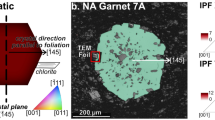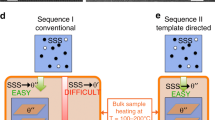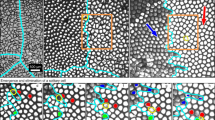Abstract
THE observation of growth spirals, as predicted by the theory of Burton, Cabrera and Frank1, on prism faces (10&1bar;0) of apatite crystals, has been reported earlier2. We have now observed completely differently shaped growth spiral patterns on tabular colourless apatite crystals from Sulzbachtal (Austria), which have probably grown from solution. The accompanying photograph (Fig. 1) shows one of the observed patterns. The direction of the c-axis is vertical. The shape and orientation of the spiral are the same in all cases. The dominating system consists of two co-operating spirals, which dominate several other dislocations of equal and of different strengths. In the latter case the formation of residual steps is noticed. Interlacing occurs in one direction. The main growth-fronts have a step-height of 140 ±.20 A.
This is a preview of subscription content, access via your institution
Access options
Subscribe to this journal
Receive 51 print issues and online access
$199.00 per year
only $3.90 per issue
Buy this article
- Purchase on Springer Link
- Instant access to full article PDF
Prices may be subject to local taxes which are calculated during checkout
Similar content being viewed by others
References
Burton, Cabrera, and Frank, Phil. Trans. Roy. Soc., A, 243, 299 (1951).
Amelinckx, S., Nature, 169, 841 (1952).
Author information
Authors and Affiliations
Rights and permissions
About this article
Cite this article
AMELINCKX, S. Growth Spirals and their Relation to Crystal Habit as Illustrated by Apatite. Nature 170, 760–761 (1952). https://doi.org/10.1038/170760b0
Issue Date:
DOI: https://doi.org/10.1038/170760b0
Comments
By submitting a comment you agree to abide by our Terms and Community Guidelines. If you find something abusive or that does not comply with our terms or guidelines please flag it as inappropriate.



